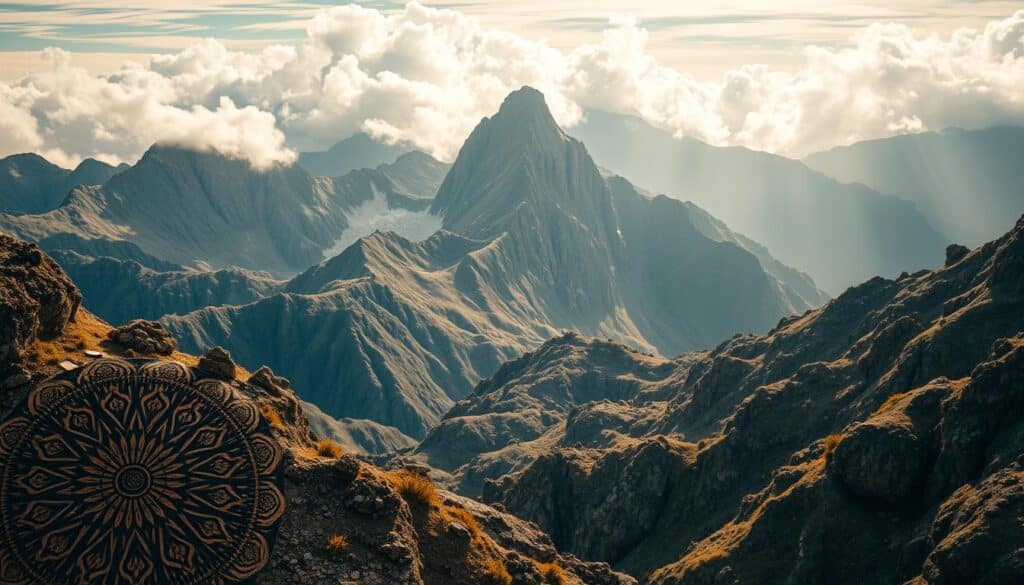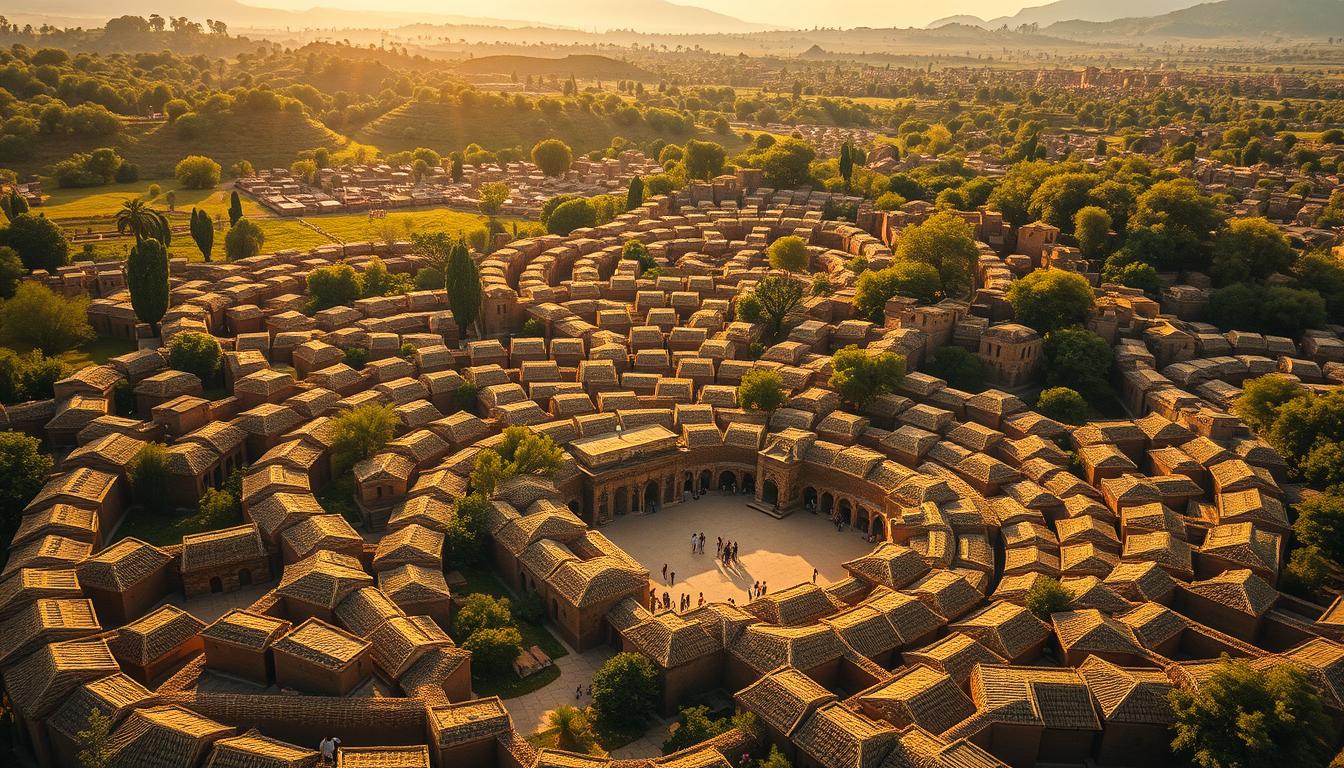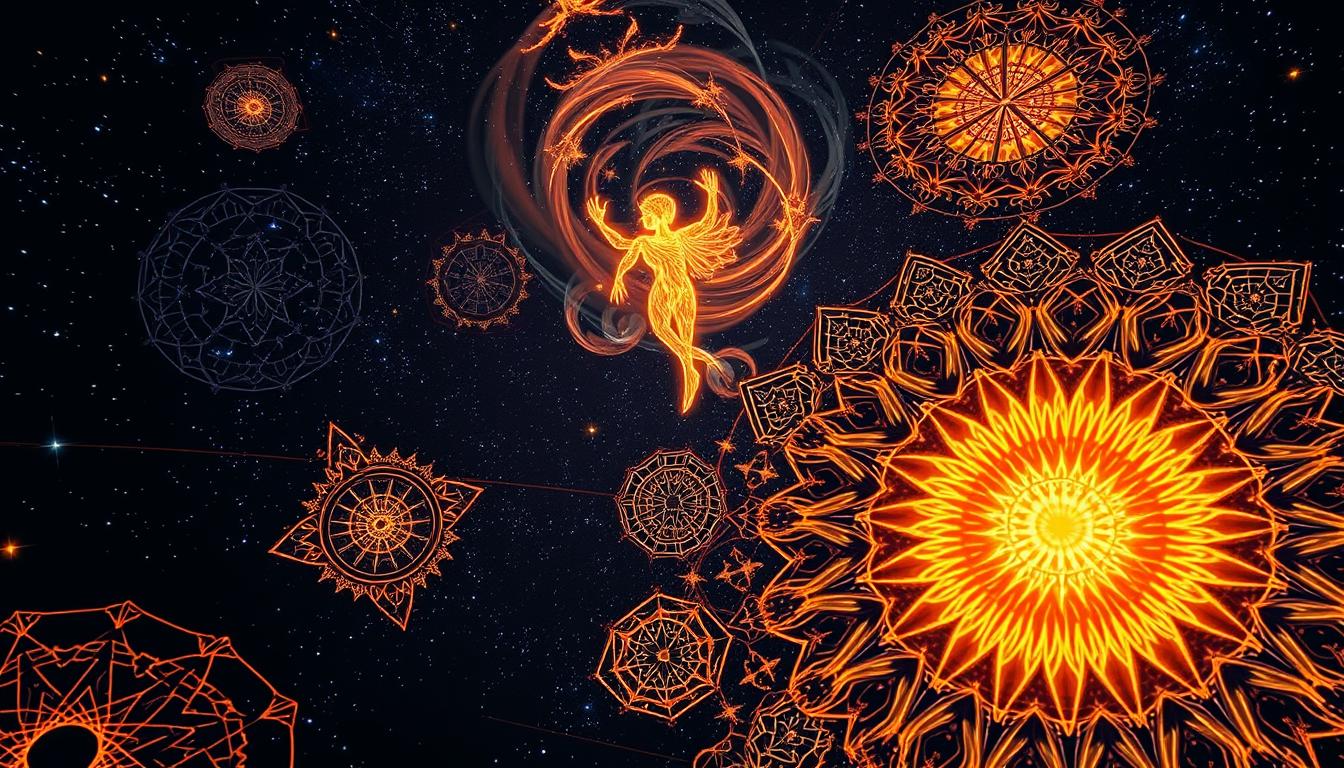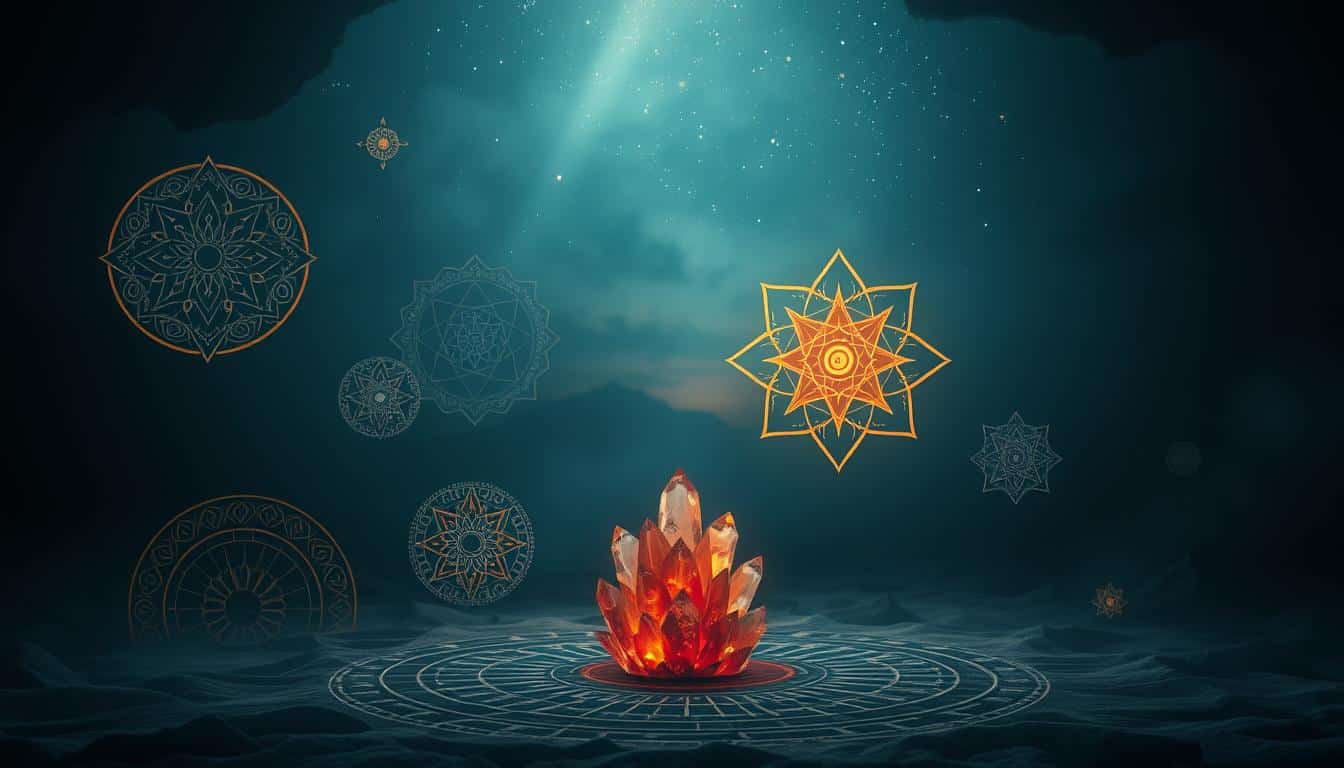Exploring fractals shows their big role in different societies. These complex shapes are a big part of traditions. They add to the arts and spirituality of indigenous people. Mainly focusing on African groups, we’ll see how fractals mix with their identities and art.
We will use work from experts like Dr. Ron Eglash. They help us see the bond between native art and nature. This shows how fractals help keep and celebrate cultural stories.
Introduction to Fractals in Indigenous Cultures
Fractals are complex geometric shapes that repeat themselves at different sizes. In indigenous cultures, these patterns are more than just math. They are important cultural symbols found in art, architecture, and traditional practices. Exploring fractals shows us how these shapes are meaningful to various groups, especially in Africa.
In these cultures, fractals are used not just because they look nice. They help tell important stories of the people. The repeating patterns in their art reflect how nature and human creativity are connected. Each pattern has a story, linking past and present, and showing the culture’s rich heritage.

Historical Context of Fractals
Fractals have been part of indigenous cultures for centuries. These societies used fractal geometry in their art and designs. This shows they knew a lot about math, which Western views often overlook. Ron Eglash’s work shows these patterns mean more than just decoration. They are deep knowledge that helped ancient civilizations in many areas of life.
Fractals are like a language that links the universe’s complexity with cultural practices. Studying them reveals the deep insights of indigenous peoples, passed down through generations. Understanding this helps us see the genius of their mathematical traditions.
Fractal Geometry: Beyond Mathematics
Fractal geometry is more than just a branch of math. It plays a crucial role in various fields beyond its origins. We see its effects in biology, where it helps explain the branching of trees and our blood vessels. In geology, it’s key to modeling landforms and grasping earth’s processes.
In computer graphics, fractals help create lifelike scenes of the natural world. This shows us not just the beauty of fractals but their practical use in solving complex problems in different industries.
Fractal geometry also holds special meaning in indigenous cultures. It connects the complexity of nature with cultural stories and traditions. This blend of math and culture highlights how indigenous peoples understand the balance of order and chaos in nature.
The Cultural Importance of Fractals in Indigenous Heritage
Fractals are deeply meaningful in indigenous heritage, linking age-old practices to architectural design. They appear in everyday life and spiritual practices, showing the strong ties in indigenous cultures.
Connection to Traditional Practices
In many indigenous communities, fractals are more than art. They’re key to rituals, storytelling, and artwork, showing how nature and culture are connected. Textiles feature fractal designs that symbolize life and nature’s cycles. Fractals strengthen community ties and cultural identity.
Fractals in Architectural Design
Indigenous architecture prominently features fractal patterns, showing a deep understanding of geometry and beauty. Villages and communal spaces often mirror fractal principles, reflecting people’s bond with their surroundings. Experts like Ron Eglash highlight these designs’ role in community organization and cultural identity, displaying a unique mix of use and elegance in indigenous buildings.
Fractals in African Design
African design uses fractal patterns to show off its cultural riches. These designs do more than please the eye. They help us see how values and connections shape societies. Geometric shapes tell stories of tradition with features like recursion and scaling.
Fractal designs are also seen in the way cities and villages are planned. They follow the natural world, creating paths and buildings that blend with the environment. This approach to architecture links people to their heritage in a meaningful way.
Geometric patterns are common in African art, from textiles to sculptures. These patterns highlight the continent’s diverse cultures. They weave together stories from different societies, showing a shared identity.
Examples of Fractal Patterns in Indigenous Art
Indigenous art is filled with fractal patterns, especially in textiles and sculptures. These designs capture our attention and tell cultural stories.
Textiles and Weaving
Fractal patterns shine in the textiles of indigenous cultures. They use patterns in mats and fabrics that look like nature. These textiles show plants or animals, linking closely with the environment.
The designs’ symmetry and repetition reflect nature’s fractal geometry. This shows how indigenous art blends beauty with cultural depth.
Sculptural Elements
Fractal patterns also appear in sculpture. In African art, for example, you’ll see these patterns in various pieces. They mix function with deeper meanings.
The repeating motifs speak to the community’s identity and history. Every carved detail demonstrates skill and conveys spiritual and cultural stories. It shows how the art’s form connects with fractal concepts.
Fractals in Spiritual and Religious Practices
Fractals have deep meaning in spiritual and religious rites across indigenous cultures. They mirror the bond among life, nature, and the universe. This reflects the communities’ beliefs and values. Spirals and repeating patterns in fractals symbolize spiritual paths. They guide people towards enlightenment and deeper insights.
In ceremonies, fractal designs enrich artworks, music, and dance. These forms are more than just decoration. They help communicate spiritual ideas. Mandala ceremonies and sacred objects show fractal geometry. This highlights unity and life’s repeating cycles.
Fractals do more than just look appealing. They are crucial in sacred spaces, raising the spiritual vibe. Here, fractals link the physical and spiritual worlds. They invite people to think about their roots and shared culture.
Impacts of Modernization on Indigenous Fractals
Modern times and indigenous cultures clash, making it hard to keep traditional fractal designs. The move towards being more alike and efficient puts old customs at risk. This change can diminish fractals’ deep cultural meanings, which show identity and heritage.
Yet, there’s hope for keeping indigenous cultures alive through modern takes on fractal principles. Indigenous artists can use new tech to bring traditional designs into today. This mix of old and new shows how strong indigenous communities are, blending culture-keeping with fresh ideas.
The effects of modern times on fractals present a tricky scene. But, with ongoing discussions, there’s hope. These talks could help keep the rich stories and teachings that fractals carry going strong.
Fractal Patterns in Oral Traditions and Folklore
Oral traditions are key for connecting generations. They showcase fractal patterns that mirror a culture’s core values and beliefs. Through vivid imagery and repeating motifs, they weave the idea of fractals into everyday life. As these stories pass from one generation to another, they capture the community’s spirit, echoing themes and ideas.
Folklore features elements similar to fractal patterns. Tales often have recurring motifs that entertain and share wisdom. This repetition helps bridge the past and present, creating a sense of unity and belonging in the culture.
Exploring the link between oral traditions and fractal patterns deepens our respect for how indigenous people share their histories. These stories form a rich tapestry, showing how life, nature, and tradition are interwoven. They maintain the community’s identity at their core.
Understanding Fractals Through Cultural Lens
Looking at fractals through a cultural lens shows us their deep importance in native wisdom. These complex patterns aren’t just math figures; they’re crucial to cultural identity too. Indigenous folks use fractals to connect with their surroundings, showing their beliefs and values.
Studying fractals this way reveals their meaningful role in merging culture with math. It sparks conversations and helps us value how native knowledge deepens our grasp of tricky ideas. This blend of math and culture opens new paths for learning and exchange, helping us celebrate different ways of understanding.
Fractals in Contemporary Indigenous Art
Today’s indigenous art is a lively mix of old and new, with a strong use of fractal designs. These complex patterns bring back age-old customs while adding newness to art forms. Artists mix classic geometric shapes with new ways to make art that means something to both history and today’s world.
Revival and Innovation
Bringing fractal designs back into indigenous art shows how key cultural history is, yet it also seeks new artistic horizons. With modern tools like digital art and installations, artists put a new spin on fractal patterns. This blend of methods leads to a richer telling of cultural stories, catching the interest of the youth and deepening their grasp of indigenous pasts.
Through fractals, artists make a visual bridge between the past and present generations. As they explore identity in today’s society, mixing traditional designs in new ways opens a discussion on cultural persistence and change.
Conclusion
Fractals hold a deep meaning in indigenous cultures. They show us the value of identity, community, and art. Through fractals, we see how deeply traditions and spiritual beliefs are connected. These patterns are more than just art. They tell stories of history and how societies view their world.
Keeping fractals alive is key in preserving cultural identities. As the world changes, it’s important to respect and protect these patterns. By doing so, indigenous communities can keep flourishing. They can also inspire the next generations. This shows the power of mixing fractals with modern art, keeping them fresh and important.
By studying fractals, we learn about their huge role in culture and community. This knowledge stresses the need to truly value and understand fractals. They play a big part in the artistic and spiritual lives of people across the globe.



